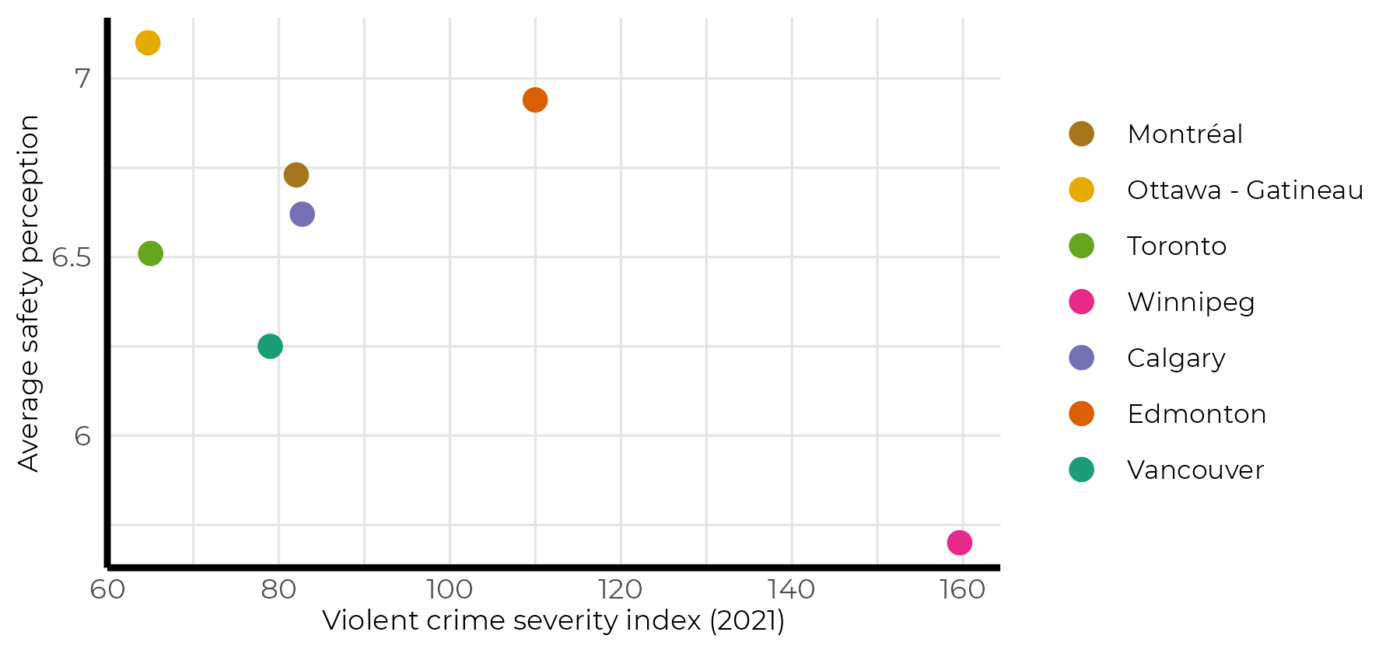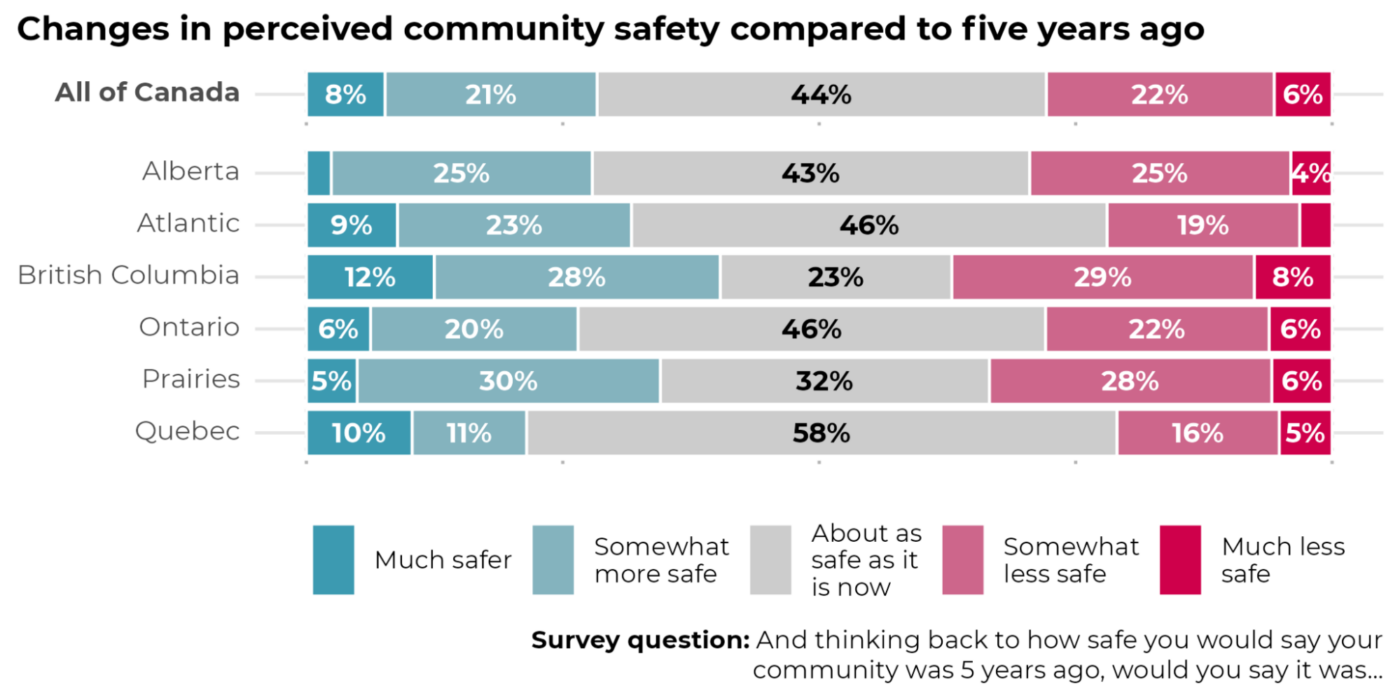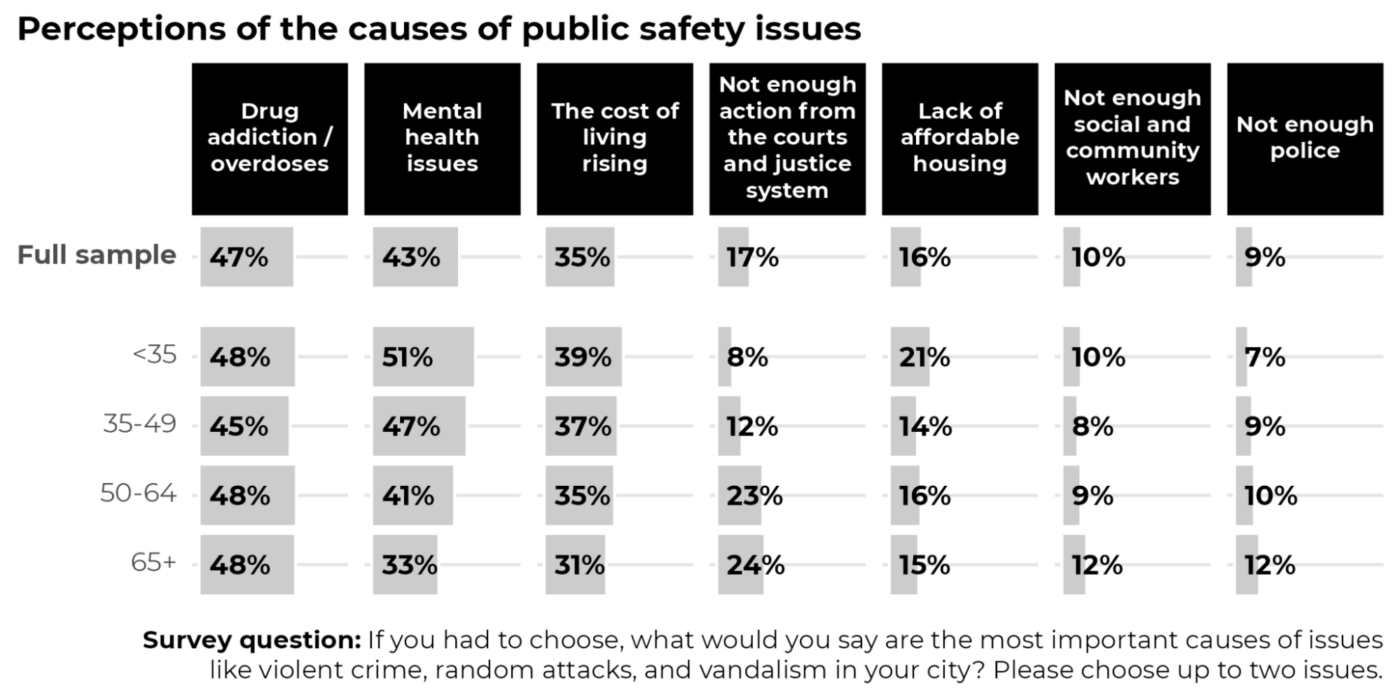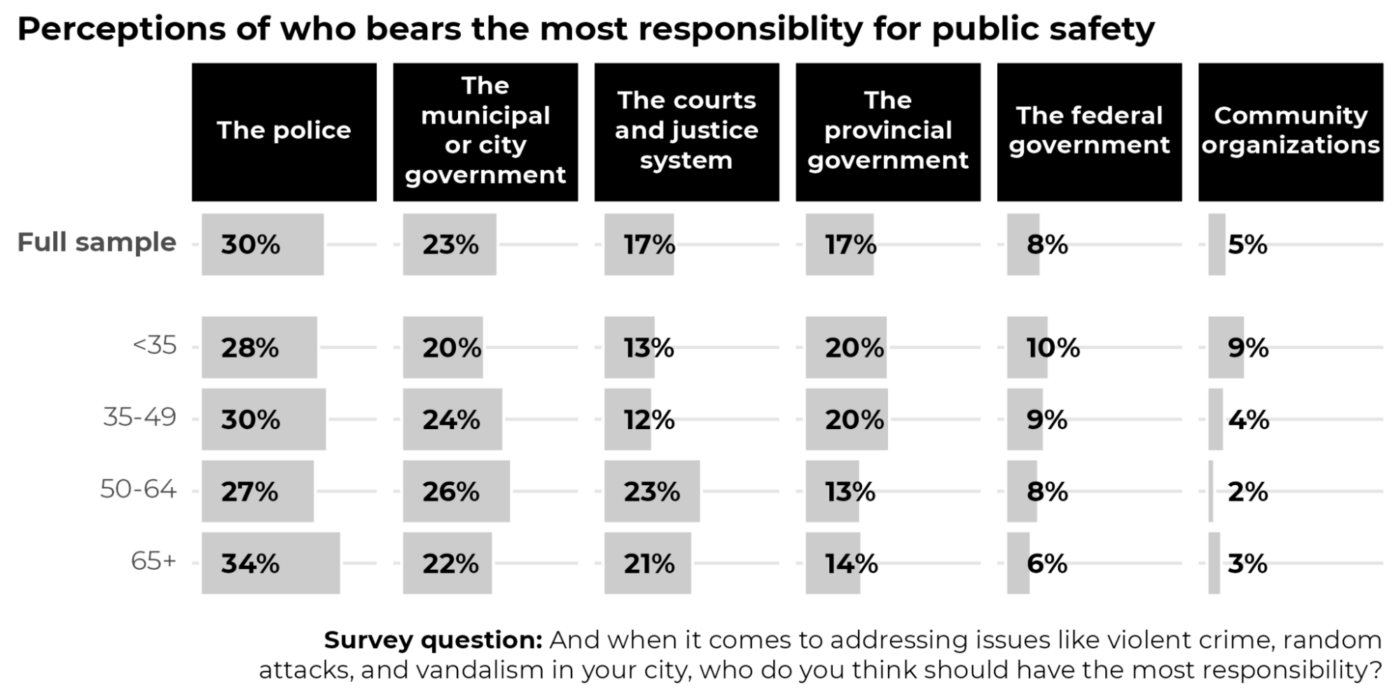How safe do Canadians feel in their communities?
March 15, 2023
Understanding perceptions of public safety in Canada
This blog provides information on findings from November 2022 as part of our Greyhound research project.
Recently, public safety issues have gained considerable attention among policymakers and everyday Canadians. For instance, random stranger attacks in Vancouver became a focal point of the city’s 2022 municipal election campaign, while debates over gun control continue at the federal level.
With this in mind, we believe it is important to understand how everyday Canadians perceive issues like violent crime, random attacks, and vandalism in their communities, as well as why these issues arise and who bears responsibility for solving them. These perceptions can influence individual behaviour and institutional decision-making, and can significantly impact trust in and satisfaction with government and law enforcement.
A 2019 survey from Statistics Canada found that 78% of Canadians were satisfied with their personal safety from crime and 74% said that crime levels in their neighbourhood had remained the same over the past five years. Of course, a lot has changed since 2019: the Covid-19 pandemic affected all of us, violent crimes have made headlines, and the toxic drug and overdose crisis has gripped many Canadian cities.
For this reason, we surveyed a representative sample of 1,000 Canadians in November 2022 with the goal of providing an up-to-date understanding of perceptions of public safety across the country.
Perceptions of community safety vary significantly across Canadian regions
Generally speaking, most Canadians feel safe at home: 60% of respondents said their communities are relatively safe when it comes to issues like violent crime, random attacks, and vandalism (giving a rating of 7 or above on a scale of 1 to 10, from extremely unsafe to extremely safe).
However, perceptions of safety varied significantly across regions — in both BC and the Prairie provinces (Manitoba and Saskatchewan), respondents rated their communities as significantly less safe (6.1/10 on average) compared to the national average (6.6/10).
On the other hand, our results suggest that Atlantic-based respondents (7.3), Quebecers (7.2), and Albertans (6.9) feel significantly safer in their communities than other Canadians.

When we take a closer look at Canada’s main metropolitan areas, publicly available data about levels of violent crime suggest that respondents tend to feel less safe in metropolitan areas with higher levels of violent crime. For instance, Winnipeg tops the list among major Canadian metropolitan areas for having the highest number of violent crimes per capita, according to Statistics Canada’s Violent Crime Severity Index. It is in Winnipeg where we also see the lowest perceptions of community safety (5.7 out of 10). On the other hand, the Ottawa – Gatineau area scores relatively low on the Violent Crime Severity Index, and respondents here see their communities as quite safe, with an average rating of 7.1.
Edmonton is somewhat of an outlier here, in that perceptions of safety are relatively high (6.9 out of 10), yet its place on the crime severity index is somewhat higher than most other main metropolitan areas. One explanation for this may be how violent crime rates have changed in recent years — over the past few years, the Violent Crime Severity Index in Edmonton has been mostly flat and has only increased by 7 points since 2017. In contrast, in Calgary, where safety perceptions are slightly lower (6.6 out of 10), the Violent Crime Severity Index has increased by 18 points over the same time period, bringing more drastic changes to the lives of the city’s residents.
Age divides on feelings of safety
The literature is conflicted on the impact of age on personal feelings of safety — in the Canadian context, we found a significant age divide, where respondents older than 65 felt significantly safer (7.1) than their younger counterparts (6.5).

However, age and demographics might be just one element of the equation — what might matter the most is the intersection of one’s socio-demographic profile with the characteristics of the communities in which they live.
Community context matters
Depending on one’s personal background, community-level factors may impact Canadians’ perceptions of safety in different ways. For instance, after controlling for a variety of individual and community-level factors, our results suggest that older (65+) respondents tend to feel less safe in communities with higher proportions of immigrants, while no such pattern is clear for younger age groups. Moreover, our predictions also suggest that respondents under 65 feel safer in communities that are older, whereas 65+ respondents feel a similar level of safety, regardless of the age profile of their community.

Many think safety in their community has changed — some say it has become safer and others believe it’s less safe
Interestingly, respondents are almost evenly split on whether their communities have become more or less safe compared to five years ago: 29% of Canadians feel that their communities have been safer, 28% think they have become less safe, and 44% say the safety levels have not really changed.

When we look closer at Canadian regions, respondents in British Columbia and the Prairie provinces (Manitoba and Saskatchewan) are more likely to perceive changes in safety within their communities compared to other parts of Canada. However — as is the case in Canada overall — opinions are split on whether safety has improved or worsened.
The reality — according to Statistics Canada’s Violent Crime Severity Index — is that violent crime has increased slightly among all Canadian provinces, with the most pronounced increases in Saskatchewan and Manitoba, where levels of violent crime were already well above the national average.

Comparing these statistics to opinions in our survey suggests that perceptions of safety are highly contextual, likely shaped by a variety of factors, including lived experience, media reports, and individual attitudes and biases. Moreover, crime rates vary significantly between different communities and regions within a province, and thus perceptions of safety — to the extent they are shaped by personal experience — may not align with overall crime trends at the provincial level.
Drug addiction and mental health issues are at the root of public safety concerns, especially according to younger Canadians
In our survey, when we asked about the most important causes of public safety threats, 69% of respondents selected either drug addiction and overdoses or mental health issues. Indeed, in cities like Vancouver, Toronto, and Calgary, local and provincial governments have proposed a number of strategies for both improving treatment for those who struggle with mental health and drug addiction, and addressing the threats to community safety that tend to arise from these issues.
Once again, context matters here — the cities and provinces hit hardest by the toxic drug crisis are significantly more likely to attribute drug addiction and overdoses or mental health issues as the main causes of public safety issues.1
Some distinct generational differences are also at play here. For instance, 51% of respondents under 35 years old saw mental health issues as one of the top two causes of public safety issues. This belief tapers down to just 33% of respondents over 65. On the other hand, older respondents are more likely than their younger counterparts to chalk this issue up to a lack of action from the courts and justice system.

1 For instance, 81% of respondents in BC selected drug addiction and overdoses or mental health issues as the main causes of public safety issues. BC also accounted for 32% of all apparent opioid toxicity deaths in Canada between January and June 2022, despite representing only 13% of the Canadian population. https://health-infobase.canada.ca/substance-related-harms/opioids-stimulants/graphs?index=15
Canadians look to local decision-makers and institutions when it comes to addressing public safety issues
Maintaining public safety involves collaboration and cooperation among various decision-makers and agencies at the federal, provincial, and municipal levels. Understandably, most Canadians are unlikely to have a comprehensive understanding of how these various actors work together to keep them safe.
For this reason, we posed the question: who is most responsible for public safety? We found that nearly half of respondents said that local actors — the police (30%) or the municipal government (23%) — should take on the most responsibility. This is somewhat unsurprising, given that these institutions are generally seen as having the authority, resources, and expertise to address threats to public safety. That said, it is notable that community organisations rank last, when some governments have argued that collaboration with these groups plays an important role in addressing the underlying issues that many respondents attributed to public safety issues, like substance abuse, mental health issues, and homelessness.
Once again, we see a significant generational divide here — respondents over 50 years old were around 10% more likely to think that the courts and justice system should be responsible for public safety, while younger respondents were somewhat more likely to place responsibility on the provincial government.

Understanding public safety concerns is one step towards addressing the problem
Though our results suggest that Canadians, on average, feel quite safe in their communities, a significant proportion still have concerns, and many think that community safety has worsened. Addressing these issues and assuaging the concerns of Canadians is no easy task. Many see mental health and substance use issues as the root cause of public safety concerns. Of course, addressing these issues can be complex and requires a multifaceted approach with collaboration across a variety of different stakeholders, including government, law enforcement, health care professionals, and community organisations. Ultimately, understanding Canadians’ perceptions of public safety can help policymakers identify potential solutions and better address the concerns of the public.
Method
Data Sciences conducted an online survey among a representative sample of Canadians (N=1,000) from Nov. 17 to Nov. 23, 2022. In this survey, we asked Canadians how safe they feel in their communities, how these feelings have changed over time, and what factors they think are contributing most to public safety issues. Survey data was weighted by gender, age and region to be representative of the Canadian population. The margin of error for a probabilistic sample of the same size is ±3%, but is larger when looking at subsets of the population.


